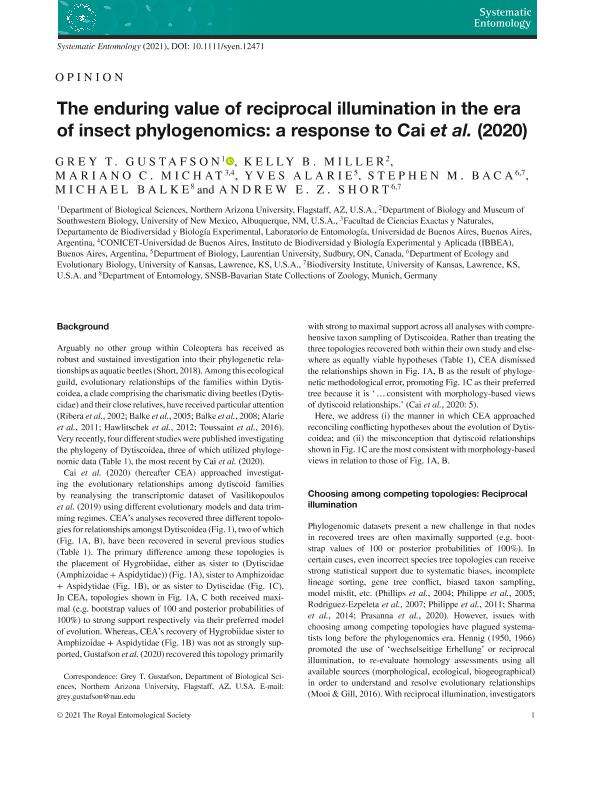Mostrar el registro sencillo del ítem
dc.contributor.author
Gustafson, Grey T.

dc.contributor.author
Miller, Kelly B.
dc.contributor.author
Michat, Mariano Cruz

dc.contributor.author
Alarie, Yves

dc.contributor.author
Baca, Stephen M.
dc.contributor.author
Balke, Michael

dc.contributor.author
Short, Andrew E. Z.
dc.date.available
2022-12-22T14:20:10Z
dc.date.issued
2021-02
dc.identifier.citation
Gustafson, Grey T.; Miller, Kelly B.; Michat, Mariano Cruz; Alarie, Yves; Baca, Stephen M.; et al.; The enduring value of reciprocal illumination in the era of insect phylogenomics: a response to Cai et al. (2020); Wiley Blackwell Publishing, Inc; Systematic Entomology (print); 46; 3; 2-2021; 473-486
dc.identifier.issn
0307-6970
dc.identifier.uri
http://hdl.handle.net/11336/182165
dc.description.abstract
Arguably no other group within Coleoptera has received as robust and sustained investigation into their phylogenetic relationships as aquatic beetles. Among this ecological guild, evolutionary relationships of the families within Dytiscoidea, a clade comprising the charismatic diving beetles (Dytiscidae) and their close relatives, have received particular attention. Very recently, four different studies were published investigating the phylogeny of Dytiscoidea, three of which utilized phylogenomic data, the most recent by Cai etal. (2020). Cai et al. (2020) (hereafter CEA) approached investigating theevolutionary relationships among dytiscoid families by reanalysing the transcriptomic dataset of Vasilikopoulos et al. (2019) using different evolutionary models and data trimming regimes. CEAs analyses recovered three different topologies for relationships amongst Dytiscoidea, two of which have been recovered in several previous studies. The primary difference among these topologies is the placement of Hygrobiidae, either as sister to (Dytiscidae (Amphizoidae + Aspidytidae)), sister to Amphizoidae + Aspidytidae, or as sister to Dytiscidae. In CEA, topologies shown in Fig. 1A, C both received maximal (e.g. bootstrap values of 100 and posterior probabilities of 100%) to strong support respectively via their preferred model of evolution. Whereas CEAs recovery of Hygrobiidae sister to Amphizoidae + Aspidytidae was not as strongly supported, Gustafson et al. (2020) recovered this topology primarily with strong to maximal support across all analyses with comprehensive taxon sampling of Dytiscoidea. Rather than treating the three topologies recovered both within their own study and elsewhere as equally viable hypotheses, CEA dismissed the relationships shown in Fig. 1A, B as the result of phylogenetic methodological error, promoting Fig. 1C as their preferred tree because it is consistent with morphology-based views of dytiscoid relationships. Here, we address (i) the manner in which CEA approached reconciling conflicting hypotheses about the evolution of Dytiscoidea; and (ii) the misconception that dytiscoid relationships shown in Fig. 1C are the most consistent with morphology-based views in relation to those of Fig. 1A, B.
dc.format
application/pdf
dc.language.iso
eng
dc.publisher
Wiley Blackwell Publishing, Inc

dc.rights
info:eu-repo/semantics/openAccess
dc.rights.uri
https://creativecommons.org/licenses/by-nc-sa/2.5/ar/
dc.subject
HYDRADEPHAGA
dc.subject
HYGROBIIDAE
dc.subject
DYTISCIDAE
dc.subject
AMPHIZOIDAE
dc.subject
ASPIDYTIDAE
dc.subject.classification
Zoología, Ornitología, Entomología, Etología

dc.subject.classification
Ciencias Biológicas

dc.subject.classification
CIENCIAS NATURALES Y EXACTAS

dc.title
The enduring value of reciprocal illumination in the era of insect phylogenomics: a response to Cai et al. (2020)
dc.type
info:eu-repo/semantics/article
dc.type
info:ar-repo/semantics/artículo
dc.type
info:eu-repo/semantics/publishedVersion
dc.date.updated
2022-09-19T16:01:14Z
dc.journal.volume
46
dc.journal.number
3
dc.journal.pagination
473-486
dc.journal.pais
Reino Unido

dc.journal.ciudad
Londres
dc.description.fil
Fil: Gustafson, Grey T.. University of Kansas; Estados Unidos
dc.description.fil
Fil: Miller, Kelly B.. University of New Mexico. Department of Biology; Estados Unidos
dc.description.fil
Fil: Michat, Mariano Cruz. Consejo Nacional de Investigaciones Científicas y Técnicas. Oficina de Coordinación Administrativa Ciudad Universitaria. Instituto de Biodiversidad y Biología Experimental y Aplicada. Universidad de Buenos Aires. Facultad de Ciencias Exactas y Naturales. Instituto de Biodiversidad y Biología Experimental y Aplicada; Argentina
dc.description.fil
Fil: Alarie, Yves. Laurentian University. Department of Biology; Canadá
dc.description.fil
Fil: Baca, Stephen M.. University of Kansas; Estados Unidos
dc.description.fil
Fil: Balke, Michael. Zoologische Staatssammlung Munchen; Alemania
dc.description.fil
Fil: Short, Andrew E. Z.. University of Kansas; Estados Unidos
dc.journal.title
Systematic Entomology (print)

dc.relation.alternativeid
info:eu-repo/semantics/altIdentifier/doi/http://dx.doi.org/10.1111/syen.12471
Archivos asociados
